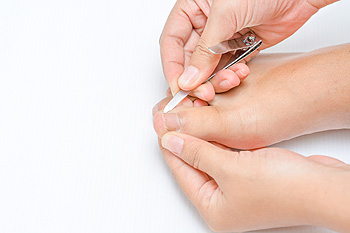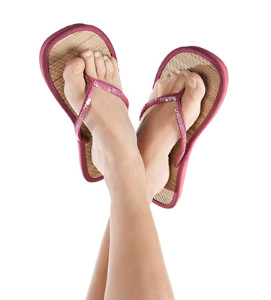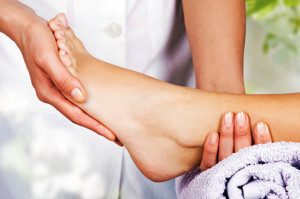Blog
The Importance of Taking Care of Diabetic Feet
 If diabetes is a condition that affects you, it is imperative that you pay special attention to your feet. Cuts on the feet may easily occur from foot injuries and can often result in infections, so it’s important to inspect your feet on a daily basis. If you can reach your toenails to properly trim them, it’s wise to do this regularly. If they are not within your grasp, please have your podiatrist trim them correctly, which is accomplished by cutting the nails straight across. The skin will benefit by being kept smooth and soft, and this can be done by utilizing a good moisturizer after washing and thoroughly drying your feet. If you choose to walk barefoot, your feet will not be protected, and it’s suggested that shoes and socks are worn for the majority of the time. If you are affected by diabetes and would like to have more information on how to take care of your feet, please schedule a consultation with a podiatrist.
If diabetes is a condition that affects you, it is imperative that you pay special attention to your feet. Cuts on the feet may easily occur from foot injuries and can often result in infections, so it’s important to inspect your feet on a daily basis. If you can reach your toenails to properly trim them, it’s wise to do this regularly. If they are not within your grasp, please have your podiatrist trim them correctly, which is accomplished by cutting the nails straight across. The skin will benefit by being kept smooth and soft, and this can be done by utilizing a good moisturizer after washing and thoroughly drying your feet. If you choose to walk barefoot, your feet will not be protected, and it’s suggested that shoes and socks are worn for the majority of the time. If you are affected by diabetes and would like to have more information on how to take care of your feet, please schedule a consultation with a podiatrist.
Diabetic foot care is important in preventing foot ailments such as ulcers. If you are suffering from diabetes or have any other concerns about your feet, contact one of our podiatrists from Westside Podiatry Center, LLP. Our doctors can provide the care you need to keep you pain-free and on your feet.
Diabetic Foot Care
Diabetes affects millions of people every year. The condition can damage blood vessels in many parts of the body, especially the feet. Because of this, taking care of your feet is essential if you have diabetes, and having a podiatrist help monitor your foot health is highly recommended.
The Importance of Caring for Your Feet
- Routinely inspect your feet for bruises or sores.
- Wear socks that fit your feet comfortably.
- Wear comfortable shoes that provide adequate support.
Patients with diabetes should have their doctor monitor their blood levels, as blood sugar levels play such a huge role in diabetic care. Monitoring these levels on a regular basis is highly advised.
It is always best to inform your healthcare professional of any concerns you may have regarding your feet, especially for diabetic patients. Early treatment and routine foot examinations are keys to maintaining proper health, especially because severe complications can arise if proper treatment is not applied.
If you have any questions please feel free to contact one of our offices located in Liverpool, Camillus, Skaneateles, Oswego, and Cicero, NY . We offer the newest diagnostic and treatment technologies for all your foot and ankle needs.
Lifestyle Changes and Gout
 The medical condition referred to as gout is the result of elevated uric acid levels in the blood. The symptoms of this uncomfortable ailment may include severe pain surrounding the big toe, swelling, and redness. Research has shown there may be triggers that may cause gout including ingesting certain medications, a sudden illness, or an injury to the joint in the toe. Additionally, many gout patients may benefit from a healthy lifestyle change, such as eliminating specific foods and drinks from their daily intake. People who consume an excess of alcohol, or eat an abundance of red meat and shellfish may be more likely to develop gout and this may be a cause of inflated uric acid levels. A podiatrist can perform a proper diagnosis, which may include having an X-ray or CAT scan taken. This will enable the soft tissue and bone to be examined. Once this condition is confirmed, the correct treatment can begin.
The medical condition referred to as gout is the result of elevated uric acid levels in the blood. The symptoms of this uncomfortable ailment may include severe pain surrounding the big toe, swelling, and redness. Research has shown there may be triggers that may cause gout including ingesting certain medications, a sudden illness, or an injury to the joint in the toe. Additionally, many gout patients may benefit from a healthy lifestyle change, such as eliminating specific foods and drinks from their daily intake. People who consume an excess of alcohol, or eat an abundance of red meat and shellfish may be more likely to develop gout and this may be a cause of inflated uric acid levels. A podiatrist can perform a proper diagnosis, which may include having an X-ray or CAT scan taken. This will enable the soft tissue and bone to be examined. Once this condition is confirmed, the correct treatment can begin.
Gout is a painful condition that can be treated. If you are seeking treatment, contact one of our podiatrists from Westside Podiatry Center, LLP. Our doctors will treat your foot and ankle needs.
What Is Gout?
Gout is a form of arthritis that is characterized by sudden, severe attacks of pain, redness, and tenderness in the joints. The condition usually affects the joint at the base of the big toe. A gout attack can occur at any random time, such as the middle of the night while you are asleep.
Symptoms
- Intense Joint Pain - Usually around the large joint of your big toe, and it most severe within the first four to twelve hours
- Lingering Discomfort - Joint discomfort may last from a few days to a few weeks
- Inflammation and Redness -Affected joints may become swollen, tender, warm and red
- Limited Range of Motion - May experience a decrease in joint mobility
Risk Factors
- Genetics - If family members have gout, you’re more likely to have it
- Medications - Diuretic medications can raise uric acid levels
- Gender/Age - Gout is more common in men until the age of 60. It is believed that estrogen protects women until that point
- Diet - Eating red meat and shellfish increases your risk
- Alcohol - Having more than two alcoholic drinks per day increases your risk
- Obesity - Obese people are at a higher risk for gout
Prior to visiting your podiatrist to receive treatment for gout, there are a few things you should do beforehand. If you have gout you should write down your symptoms--including when they started and how often you experience them, important medical information you may have, and any questions you may have. Writing down these three things will help your podiatrist in assessing your specific situation so that he or she may provide the best route of treatment for you.
If you have any questions, please feel free to contact one of our offices located in Liverpool, Camillus, Skaneateles, Oswego, and Cicero, NY . We offer the newest diagnostic and treatment technologies for all your foot care needs.
Different Types of Foot Surgery
 The feet and ankles undergo pressure as a result of consistent weight and gradually endure wear and tear as time progresses. Some patients develop arthritis, which can produce considerable pain and discomfort. This inflammation may affect the smaller bones in the foot, and may require surgery to obtain relief. If you are suffering from the pain of a bunion, surgery may be a viable option for permanent removal. This type of surgery is referred to as an osteotomy, and this involves straightening the big toe. If you have developed hammertoe, a procedure that is known as arthroplasty will repair the flexibility in the affected joints. If the plantar fascia should become inflamed, minor surgery may be performed that will separate this tissue from the heel bone. Please consider consulting with a podiatrist if you would like additional information about the many different types of foot surgery.
The feet and ankles undergo pressure as a result of consistent weight and gradually endure wear and tear as time progresses. Some patients develop arthritis, which can produce considerable pain and discomfort. This inflammation may affect the smaller bones in the foot, and may require surgery to obtain relief. If you are suffering from the pain of a bunion, surgery may be a viable option for permanent removal. This type of surgery is referred to as an osteotomy, and this involves straightening the big toe. If you have developed hammertoe, a procedure that is known as arthroplasty will repair the flexibility in the affected joints. If the plantar fascia should become inflamed, minor surgery may be performed that will separate this tissue from the heel bone. Please consider consulting with a podiatrist if you would like additional information about the many different types of foot surgery.
Foot surgery is sometimes necessary to treat a foot ailment. To learn more, contact one of our podiatrists of Westside Podiatry Center, LLP. Our doctors will assist you with all of your foot and ankle needs.
When Is Surgery Necessary?
Foot and ankle surgery is generally reserved for cases in which less invasive, conservative procedures have failed to alleviate the problem. Some of the cases in which surgery may be necessary include:
- Removing foot deformities like bunions and bone spurs
- Severe arthritis that has caused bone issues
- Cosmetic reconstruction
What Types of Surgery Are There?
The type of surgery you receive will depend on the nature of the problem you have. Some of the possible surgeries include:
- Bunionectomy for painful bunions
- Surgical fusion for realignment of bones
- Neuropathy decompression surgery to treat nerve damage
Benefits of Surgery
Although surgery is usually a last resort, it can provide more complete pain relief compared to non-surgical methods and may allow you to finally resume full activity.
Surgical techniques have also become increasingly sophisticated. Techniques like endoscopic surgery allow for smaller incisions and faster recovery times.
If you have any questions please feel free to contact one of our offices located in Liverpool, Camillus, Skaneateles, Oswego, and Cicero, NY . We offer the newest diagnostic and treatment technologies for all your foot and ankle needs.
Symptoms of Cracked Heels
 If you have ever experienced a foot condition that is known as cracked heels, you may be aware of the pain and discomfort that is often associated with it. The skin on the heels often becomes dry and hardened, and this typically indicates that the condition is beginning to develop. There may be several causes for this to occur, including a predisposition to skin conditions, which may include psoriasis or eczema, or other medical maladies such as diabetes or thyroid concerns. If the patient is diabetic, the cracks or fissures may not be felt, which may be due to a condition that is referred to as diabetic neuropathy. This may cause a lack of sensation and any pain and discomfort that is present may not be noticed. If you feel you are developing cracked heels, it’s important to confer with a podiatrist who can advise you on how to properly treat this condition, which may be helpful in attaining maximum comfort.
If you have ever experienced a foot condition that is known as cracked heels, you may be aware of the pain and discomfort that is often associated with it. The skin on the heels often becomes dry and hardened, and this typically indicates that the condition is beginning to develop. There may be several causes for this to occur, including a predisposition to skin conditions, which may include psoriasis or eczema, or other medical maladies such as diabetes or thyroid concerns. If the patient is diabetic, the cracks or fissures may not be felt, which may be due to a condition that is referred to as diabetic neuropathy. This may cause a lack of sensation and any pain and discomfort that is present may not be noticed. If you feel you are developing cracked heels, it’s important to confer with a podiatrist who can advise you on how to properly treat this condition, which may be helpful in attaining maximum comfort.
If the skin on your feet starts to crack, you may want to see a podiatrist to find treatment. If you have any concerns, contact one of our podiatrists from Westside Podiatry Center, LLP. Our doctors can provide the care you need to keep you pain-free and on your feet.
Cracked Heels
It is important to moisturize your cracked heels in order to prevent pain, bleeding, and infection. The reason cracked heels form is because the skin on the foot is too dry to support the immense pressure placed on them. When the foot expands, the dry skin on the foot begins to split.
Ways to Help Heal Them
- Invest in a good foot cream
- Try Using Petroleum Jelly
- Ease up on Soaps
- Drink Plenty of Water
Ways to Prevent Cracked Heels
- Moisturize After Showering
- Skip a Shower
- Keep Shower Water Lukewarm
- Don’t Scrub Your Feet
If you are unsure how to proceed in treating cracked heels, seek guidance from a podiatrist. Your doctor will help you with any questions or information you may need.
If you have any questions, please feel free to contact one of our offices located in Liverpool, Camillus, Skaneateles, Oswego, and Cicero, NY . We offer the newest diagnostic and treatment technologies for all your foot care needs.
Heel Pain Can Be Treated!
Reminder: When Was the Last Time...?
Flip Flops and Foot Health
 Many people enjoy the simplicity of wearing flip flops. They are easy to slip into, which makes them a desirable shoe to wear. Despite their popularity, research has indicated they can be harmful to the feet. The arch is typically absent in this type of shoe, which may cause pain in the feet and ankles. Additionally, flip flops lack shock absorption, and there is minimal cushioning in the heel area. Many people also have to curl their toes which helps to provide stability in these shoes, and this may change the way you walk. It is beneficial wear shoes that have a strap on the back, which aids in supporting the foot. If you would like additional information about how flip flops affect the feet, it is suggested that you consult with a podiatrist.
Many people enjoy the simplicity of wearing flip flops. They are easy to slip into, which makes them a desirable shoe to wear. Despite their popularity, research has indicated they can be harmful to the feet. The arch is typically absent in this type of shoe, which may cause pain in the feet and ankles. Additionally, flip flops lack shock absorption, and there is minimal cushioning in the heel area. Many people also have to curl their toes which helps to provide stability in these shoes, and this may change the way you walk. It is beneficial wear shoes that have a strap on the back, which aids in supporting the foot. If you would like additional information about how flip flops affect the feet, it is suggested that you consult with a podiatrist.
Flip-flops are not always the best choice of footwear. If you have any concerns about your feet or ankles, contact one of our podiatrists from Westside Podiatry Center, LLP. Our doctors will assist you with all of your foot and ankle needs.
Flip-Flops and Feet
When the weather starts warming up, people enjoy wearing flip-flops. Flip-flops are comfortable, stylish, and easy to slip on and off; they're perfect for any summer beach goer. However, these shoes can cause harm to the feet.
How Can Flip-Flops Affect Me Long-Term?
- Ankle problems
- Hip problems
- Lower back problems
- Pain in the balls of the feet
- Problems with foot arches
- Changes in the way you walk
Are There Injuries Associated with Flip-Flops?
Yes. Since flip-flops are relatively weak and do not provide the same amount of support as sneakers, people who wear flip-flops regularly are more susceptible to injuries. On top of that, the open nature of the shoe makes your feet more prone to other problems, such as cuts and even infections. Common injuries and ailments include:
- Sprained ankles
- Blisters
- Infections
- Cuts and Scrapes
I like Wearing Flip-Flops. Are There Safe Alternatives?
When buying flip-flops, try to find ones that have sturdy soles and that are made of high-quality materials that will support for your feet. These flip-flops will cost more but will also last longer as a result.
If you have any questions please feel free to contact one of our offices located in Liverpool, Camillus, Skaneateles, Oswego, and Cicero, NY . We offer the newest diagnostic and treatment technologies for all your foot and ankle needs.
It's Time for Beautiful Feet
Wounds That Don't Heal Need to Be Checked
How to Maintain Good Foot Health While Working
 Many people experience painful foot conditions as the aging process occurs. Standing and walking for the majority of the day can put unwanted pressure on the feet, so there are measures that can be taken which may help to prevent foot ailments. These can include wearing shoes that fit correctly, and making sure there is adequate room for the toes to move freely in. When the feet are frequently moisturized, uncomfortable skin conditions may be avoided. Additionally, people who stand for extended periods of time may benefit from performing gentle stretching techniques throughout the work day. Trimming the toenails correctly can aid in preventing ingrown toenails and practicing good foot hygiene can help the feet to feel good. If you would like additional information about proper foot care, it is suggested to consult with a podiatrist.
Many people experience painful foot conditions as the aging process occurs. Standing and walking for the majority of the day can put unwanted pressure on the feet, so there are measures that can be taken which may help to prevent foot ailments. These can include wearing shoes that fit correctly, and making sure there is adequate room for the toes to move freely in. When the feet are frequently moisturized, uncomfortable skin conditions may be avoided. Additionally, people who stand for extended periods of time may benefit from performing gentle stretching techniques throughout the work day. Trimming the toenails correctly can aid in preventing ingrown toenails and practicing good foot hygiene can help the feet to feel good. If you would like additional information about proper foot care, it is suggested to consult with a podiatrist.
While working on the feet, it is important to take the proper care of them. For more information about working on your feet, contact one of our podiatrists from Westside Podiatry Center, LLP. Our doctors will treat your foot and ankle needs.
Working on Your Feet
Standing on your feet for long periods of time can cause stress and pain in your feet. Your whole body may experience change in terms of posture, back pain, bunions, callouses and or plantar warts. There are ways to avoid these conditions with proper foot care, smart choices and correct posture.
Positive Changes
Negative heeled shoe – Choosing this shoe type places the heel slightly lower than the ball of the foot. These are great for overall foot health. Find shoes that fit you correctly.
Go barefoot – Our feet were not designed to be enclosed for all hours of the day. Try to periodically expose your feet to air.
Eliminate Pain
Foot Exercises – Performing simple exercises, incorporating yoga and doing stretches are beneficial. This will allow increased blood flow to the area and muscles of the foot.
Achilles tendon – Stretching the foot out flat on the floor will relax the calf muscles and tendon. These exercises can be performed almost anywhere. Make sure you add these exercises to your daily regimen.
With a little bit of this information and knowing more about foot health, you will notice changes. Foot stretches and proper footwear will help with pain and prevent further issues.
If you have any questions please feel free to contact one of our offices located in Liverpool, Camillus, Skaneateles, Oswego, and Cicero, NY . We offer the newest diagnostic and treatment technologies for all your foot and ankle needs.
More...
Do Your Child's Feet Hurt?
Before you start dancing...
Stretching And Massaging The Feet
 Many people have tired feet at the end of a working day. Reflexology can help ease sore feet and may be beneficial in preventing specific foot conditions. During reflexology, a certain amount of pressure is applied to different parts of the feet to ease pain. Stretching the calves during reflexology may also help release tension that can build up in the legs during the day. A foot massage with essential oils can also be therapeutic for the feet and may positively enhance the emotional state of the patient. If you would like to learn more about different types of foot therapy, consult with a podiatrist.
Many people have tired feet at the end of a working day. Reflexology can help ease sore feet and may be beneficial in preventing specific foot conditions. During reflexology, a certain amount of pressure is applied to different parts of the feet to ease pain. Stretching the calves during reflexology may also help release tension that can build up in the legs during the day. A foot massage with essential oils can also be therapeutic for the feet and may positively enhance the emotional state of the patient. If you would like to learn more about different types of foot therapy, consult with a podiatrist.
Foot therapy is often necessary for those recovering from either foot deformities or foot injuries. If you have concerns regarding therapy, one of our podiatrists of Westside Podiatry Center, LLP. Our doctors can provide the care you need to keep you pain-free and on your feet.
Most Common Injuries
People who are active or athletes are prone to a variety of injuries. Therefore, it is often important to take part in physical therapy in order to quickly get back on the right track.
What to Do When Injured
Physical Therapy – This specialized treatment will focus on the affected area, speeding up recovery and the overall healing process. It is a proven method that has helped millions of people return from any injury.
During physical therapy you will undergo regimented training to get back into full form. Training is often very difficult, especially at first when the foot feels weak. Physical therapy often involves:
Basic stretching and twisting exercises – getting the feet’s mobility and flexibility up.
Massaging – the therapist will massage the injured area in order to activate the muscles and relax them.
Strengthening Exercises – this allows the muscles in the affected area to regain their full strength, a vital step towards full recovery.
If you have any questions please feel free to contact one of our offices located in Liverpool, Camillus, Skaneateles, Oswego, and Cicero, NY . We offer the newest diagnostic tools and technology to treat your foot and ankle needs.







